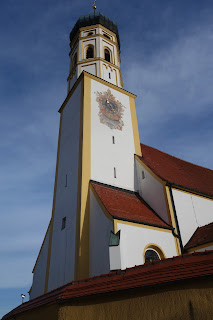As we headed out of Steinebach, we passed an architect's office with a pair of snowpeople outside. It hasn't snowed in Steinebach yet this winter, so we're guessing someone drove down to the Alps to pick up a carload of snow.
It is, however, finally below freezing. The hills were covered with hoarfrost.
Along Steinebacher Weg, heading toward Hechendorf, we saw this bucolic scene featuring Kloster Andechs on the middle-ground morraine and our friend the unfenced cow in the foreground meadow.
Our favorite lone-tree-on-a-hill, in sunlight instead of rain:
Proof that E was there. He took his hat off for this photo.
An underpass in Hechendorf:
I didn't take any photos up at Schloss Seefeld, but several of its galleries were open (on a Sunday!). E and I peeked inside one that was exhibiting intricate, bold necklaces made from copious quantities of silver, exotic feathers, and Bergkristalle ("mountain crystals," known as rock crystals in English--large pieces of remarkably clear quartz). The artist's mother was staffing the store, and she spoke enthusiastically with us about the art. Some of the pieces were displayed on MOOSE ANTLERS. I resisted saying "Wow!! European moose antlers!!" and launching into a discussion of moose, Elch, wapiti, and etymology (mainly because I couldn't remember the German word for "antlers"--Geweih).
Schloss Seefeld was the far point of our loop. Heading back through Seefeld, we came upon the village war memorials: WWI memorial (background), WWII memorial (middle ground), and "Over 60 years of peace 2008" marker (foreground).
Oberalting's St. Peter and Paul Church. The base of the tower dates back to the 15th century; the church was rebuilt and baroquified in the 17th century. The clock and sundial date from 1963.
We had seen multiple 3M signs on our walk, and decided to intentionally follow one. We were glad we did, because otherwise...
...Carly would not have been able to converse with the local chickens, who turned out to be cousins. (Conversing through the fence was a little weird.)
Signs indicate that a 3M factory indeed exists on the hill above Oberalting. E and I were intrigued that the three entrances are numbered 2, 1, and 3. (S says this is because the visitor entrance is the main entrance. We imagine verbal directions might be something like, "Please use entrance #1, the visitors' entrance. It's the second entrance on your right.")
Cars were zipping by us on the road to 3M, so we decided to skip finding the factory and instead cut through a field on a tractor path, hoping to rejoin a trail.
 |
| Some of the tractor tracks were filled with ice. |
Our plan was foiled by an electric fence, so we turned back. The valley below us was illuminated with golden light.
We continued through the fields on a path that led us past a horse farm...
...over a bridge...
...through the fields...
 |
| Look! Up there on the hill! It's the 3M factory! |
...to Meiling. This is St. Margarethe Church.
We were treated to some fabulous views as we headed up the road back to Steinebach. Every 50 meters or so, I'd say, "here E, hold my hat so I can take some pictures." E finally said, "you know, you take something like 300 photos every time we go for a walk, but you only keep, like, 10 of them. Why don't you just take those 10 and skip the rest?"
 |
| E kept saying the sky looked like a rainbow, and my camera agreed. |




















































